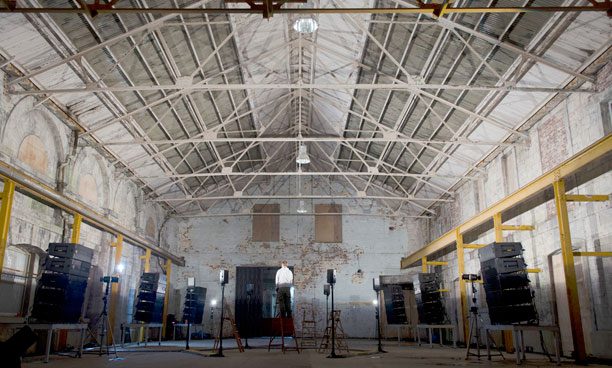
Fathom is a new ‘sonic artwork’ by Plymouth University media arts specialists Jane Grant and Dr John Matthias. It uses a ‘sonic sea level’ with the audience beneath ocean and able to climb steps to emerge into a different soundscape.
New-generation technology creates an artificial surface 6ft above the floor of a 17th century Royal Navy victualing yard, providing two distinct sonic experiences in the same space – a combination of live and recorded sounds allow visitors hear sounds below the surface of the estuary and to lift their heads above the Fathom to hear the sounds above the water. With sound handled by RG Jones, and lighting and staging by Pyramid AV, Martin Audio’s Multi-cellular Loudspeaker Array (MLA) plays an essential role.
Unveiled at the launch of a major cultural festival celebrating the River Tamar, the installation celebrates one of the UK’s most diverse waterways. Producer of the event and masterminding the audio production was experienced sound engineer Simon Honywill, who has lectured for many years at the nearby Deep Blue Sound and has been a strong advocate of Martin Audio’s technology since it was launched. Underwater sound recording technology was provided by Thomas Gordon at VP Marine.
‘Of all the challenges I have had in my career – and there have been many – it is fitting that my home town of Plymouth should come up with the most intriguing, demanding and wholly satisfying piece of work I can remember,’ Honywill says.
‘The city rests between two estuaries, the Plym and the Tamar, and despite the fact that the Plym gave up its name to the city, it is the seemingly bottomless Tamar that is the major waterway, dividing Devon from Cornwall. It is now, whilst still a busy waterway, a common thread for a wide group of artists of many kinds, and it is art that unexpectedly brought the Tamar and Martin Audio’s MLA system together.’
The installation’s recordings were made on the river by the two artists. ‘Some were familiar sonic events, some less so – but how many get to hear them below the waves?’ Honywill asks. The recordings were to be complemented with live input from a pair of hydrophones, electrical instruments for detecting or monitoring sound under water, which delivered a constant picture of the activity down in the deep throughout an entire weekend.
‘The key element of Fathom that John and Jane wanted to convey was the divide between water and air, and Jane’s concept was to create a boundary at one fathom (6ft 6in) from the floor where visitors to the piece could climb steps and emerge from the sonic water into the very different atmosphere above. It was up to me to find a way of achieving this convincingly.’
He felt that the answer lay in the Martin Audio MLA – designed to accurately place sound where it is required, and keep it away from where it is not. ‘It was the only way I could even start to generate the kind of sharp cut-off that this unique project demanded, and the only system I am aware of that can be programmed to make deep holes in its coverage,’ he explains.
The underwater experience would consist of eight stacks of five MLA in a space 30m x 15m, and the air experience would be a ring of six Martin Audio DD6 (Differential Dispersion) speakers on tall stands in the centre of the space, where listeners would climb up steps into a stereo soundscape generated by a pair of DPA 2011 mics rigged over the water where the live hydrophones were placed.
Honywill admits he had no idea how well this would work: ‘I was asking the system to cover no more than about 7m, tail off rapidly and create a hole in the coverage at 6ft 6in from the floor. It was really pushing the envelope – audio quality was not necessarily high priority but the software said it was possible.
‘I must have tried about ten different configurations in Display 2 [Martin Audio’s proprietary software] before settling on the final one that got rigged. I only had one chance to get it right too, as budget constraints meant that I had crew for four hours and that was it. Fortunately this approach was successful, as there was no way I could re-rig 40 MLA enclosures on my own.’
‘With our advanced multi-cellular systems we have introduced a new way of controlling sound systems,’ says Andy Davies, from Martin Audio Application Support. ‘With a desire to push the boundaries and advance the art and science of sound reinforcement it was a great honour for Martin Audio to be involved in this project.’
More: www.rgjones.co.uk
More: www.martin-audio.com